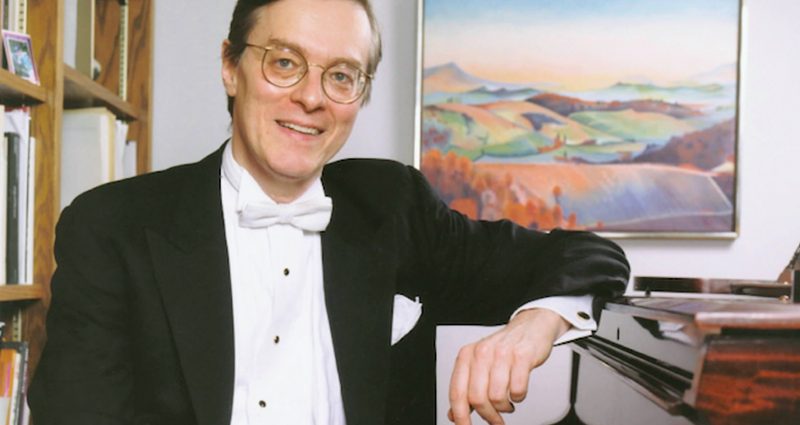- This event has passed.
PETER SERKIN
This rebroadcast is dedicated in memory of Peter, who passed away on February 1, 2020.
OLIVER KNUSSEN (1952-2018)
Variations, Op. 24
Played in loving memory of Olly.
WOLFGANG AMADEUS MOZART (1756-1791)
Adagio in B Minor, K. 540
WOLFGANG AMADEUS MOZART (1756-1791)
Piano Sonata No. 17 in B-flat Major, K. 570
I. Allegro
II. Adagio
III. Allegretto
— Intermission —
ROBERT SCHUMANN (1810-1856)
Waldszenen, Op. 82
I. Eintritt
II. Jäger auf der Lauer
III. Einsame Blumen
IV. Verrufene Stelle
V. Freundliche Landschaft
VI. Herberge
VII. Vogel als Prophet
VIII. Jagdlied
IX. Abschied
WOLFGANG AMADEUS MOZART (1756-1791)
Piano Sonata No. 8 in A Minor, K. 310
I. Allegro maestoso
II. Andante cantabile con espressione
III. Presto
This concert is a rebroadcast from Sunday, July 29, 2018 at Studzinski Recital Hall. It will be available to view on demand for 48 hours after this live rebroadcast.
PROGRAM NOTES
OLIVER KNUSSEN
Variations, Op. 24 (1989)
Peter Serkin’s piano recital begins with a work by the celebrated British composer Oliver Knussen, who died in 2018. His career got off to an auspicious start in 1968, when, at the age of fifteen, he conducted the London Symphony Orchestra’s performance of his own first symphony; studies with John Lambert and Gunther Schiller, in addition to robust encouragement from Benjamin Britten, set Knussen on his path toward an illustrious life as a leading composer of the twentieth and twenty-first centuries. Knussen composed Variations, Op. 24, for Peter Serkin, and wrote the following program note to accompany the work:
“My Variations were composed in September-October 1989, partly from sketches made during the previous spring. Although they are concise – the twelve variations play for a little more than six minutes in all – I have tried to integrate some highly contrasted textural and expressive approaches to a very limited amount of raw material (the theme is itself variations on its first six notes) within a three-part dramatic design: an initial group of five character-variations, a central passacaglia enclosing four more variations, and a final set of three, more etude-like variations functioning as coda to the whole. I should like to acknowledge some things which were constantly in mind while composing this piece: the variation of Stravinsky, Copland, and Webern, which provided positively intimidating models of richness of design and character in extreme concision; and the artistry and musical intelligence of Peter Serkin, for whom it was commissioned and who was a constant source of encouragement during the composition. My Variations are dedicated affectionately to Peter and Regina Serkin.”
WOLFGANG AMADEUS MOZART
Adagio in B Minor, K. 540 (1788)
Piano Sonata No. 17 in B-flat Major, K. 570 (1789)
Piano Sonata No. 8 in A Minor, K. 310 (1778)
ROBERT SCHUMANN
Waldszenen, Op. 82 (1848-49)
The rest of Mr. Serkin’s program is organized around a spectrum of Mozart’s keyboard shades, spanning from melancholy to mirth and back again, straddling a decade of Mozart’s short but dense career. Mozart composed eighteen keyboard sonatas in his life (that we know of), but he came to the form relatively late. He was nearly twenty when he composed his Piano Sonata No. 1 (K. 279) (for perspective, he had already composed nearly ten operas by that time, and had written sixteen violin sonatas by the age of ten). In all likelihood, Mozart had not written keyboard sonatas earlier because he didn’t need to – he could improvise and perform sonatas at will, and would not have felt compelled to fix them in ink. It is plausible that even these sonatas, which were written down, were rooted in improvisation or spawned improvisation as Mozart toured Europe.
Mr. Serkin’s own tour of three of Mozart’s keyboard works starts at the end of the chronological spectrum, with the Adagio, a work which is mysterious in both character and conception as a standalone slow movement, the only complete piece Mozart ever composed in B minor. Mozart intensifies the brooding key signature with diminished harmonies early and often, the work’s protracted chromaticism giving way to a glimpse of B major resolution only in the final moments. Composed in March 1788, Mozart’s biographers have been tempted to link the doleful Adagio to the death of Mozart’s father, Leopold, the previous year; while such romanticized connections are often at odds with the mundane reality of Mozart’s material motives for composing certain works, the absence of any obvious external stimulus for the Adagio leaves us at liberty to imagine such possible connections.
In this light, the Adagio forms a mournful symmetry with the Sonata in A Minor, K. 310, composed a decade earlier, during an unquestionably tragic period of Mozart’s life. Having left his position in Salzburg, Mozart sought a fulfilling position elsewhere in Europe. His mother, who reluctantly accompanied him on the journey, died from a sudden and unexpected illness while the two were in Paris; Mozart, deeply shaken, was not consoled when his father cruelly blamed him for his mother’s death. These circumstances have again brought scholars and audiences to postulate a connection between Mozart’s grief and this rare, minor-key sonata composed in the aftermath of his loss.
Two bands of sunlight, in the key of B-flat major, shine through these vulnerable works. First, Mozart’s Sonata No. 17, composed in 1789, his penultimate work in the genre. Its relative technical simplicity makes it a natural pairing with the Sonata No. 16, K. 545, to which Mozart marked “for beginners.” What might count as simplicity, however, has also been viewed as an utter distillation of Mozart’s sonata style; this was the view of Alfred Einstein, who considered the K. 570 “the ideal” Mozart piano sonata, “the most completely rounded of them all.” And second, Schumann’s Waldszenen, a suite of miniatures evoking the Romantic lust for the natural world. Composed over an eighteen-month span in 1848-49, Waldszenen is one of Schumann’s later piano cycles, its imagery providing a contrast with the abstract forms of Mozart’s sonatas. Schumann’s capacious forest accommodates not only flora and fauna, but also embraces human encounters and spills into the charmed world of fairytales. His miniatures themselves are fragmentary – episodic glimpses rather than panoramas – their asymmetrical forms resembling the natural growth of branches, their sequence mimicking the twists and turns of a woodland path.
Program Notes by Peter Asimov
SPONSORS
This is concert is generously sponsored by:









